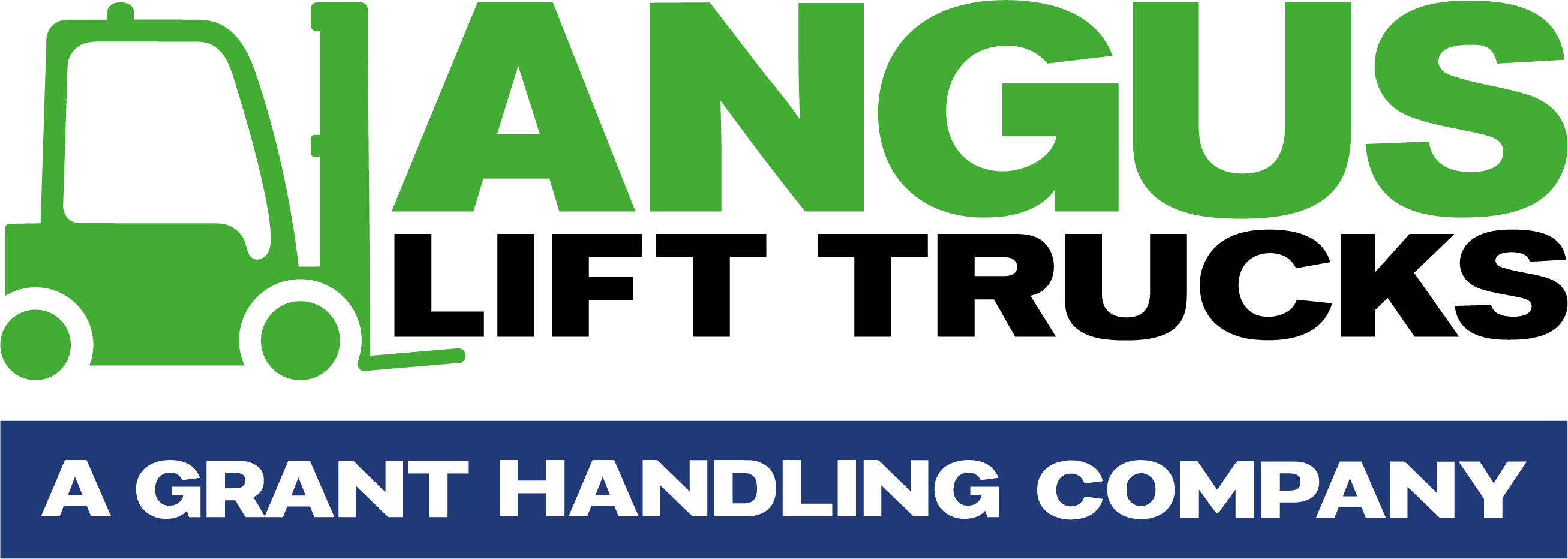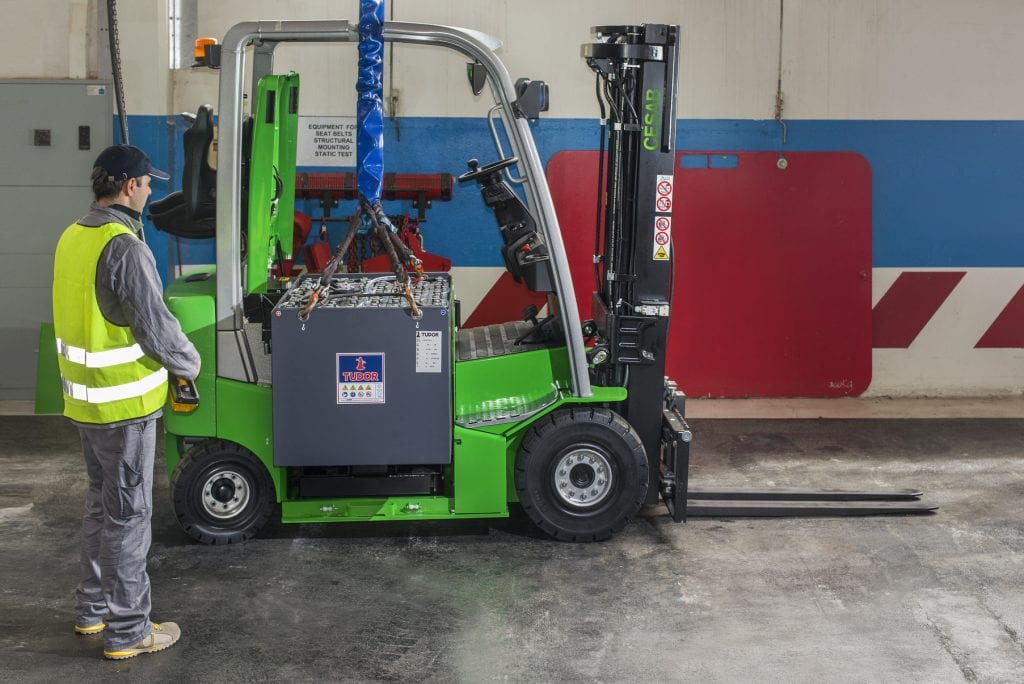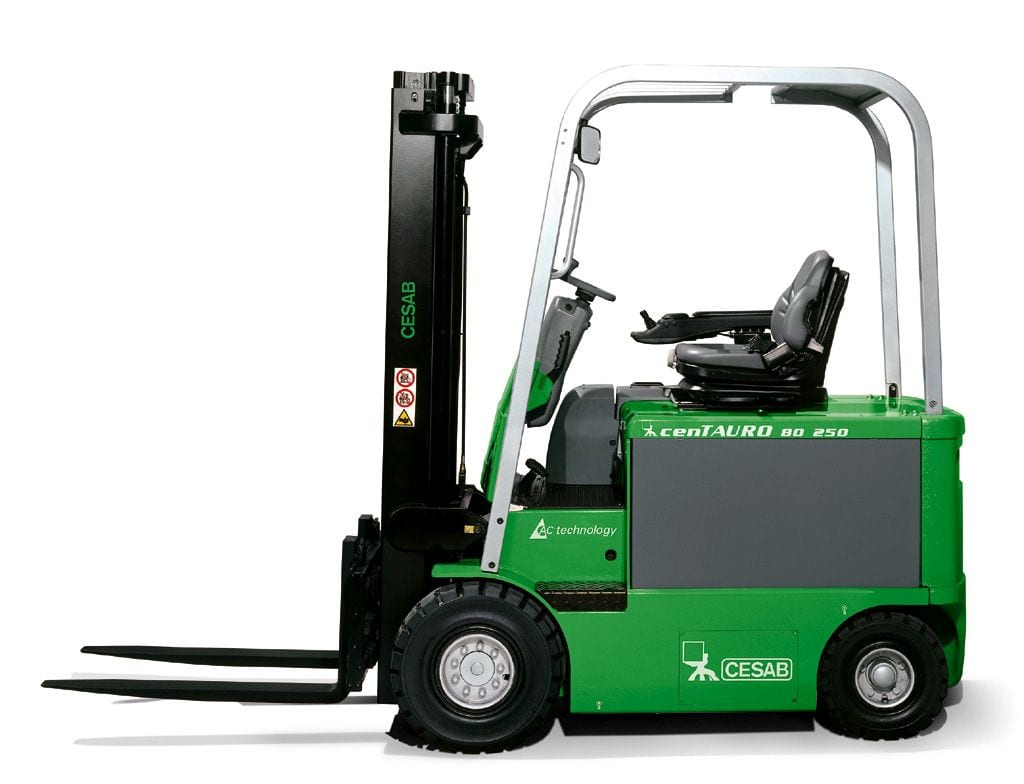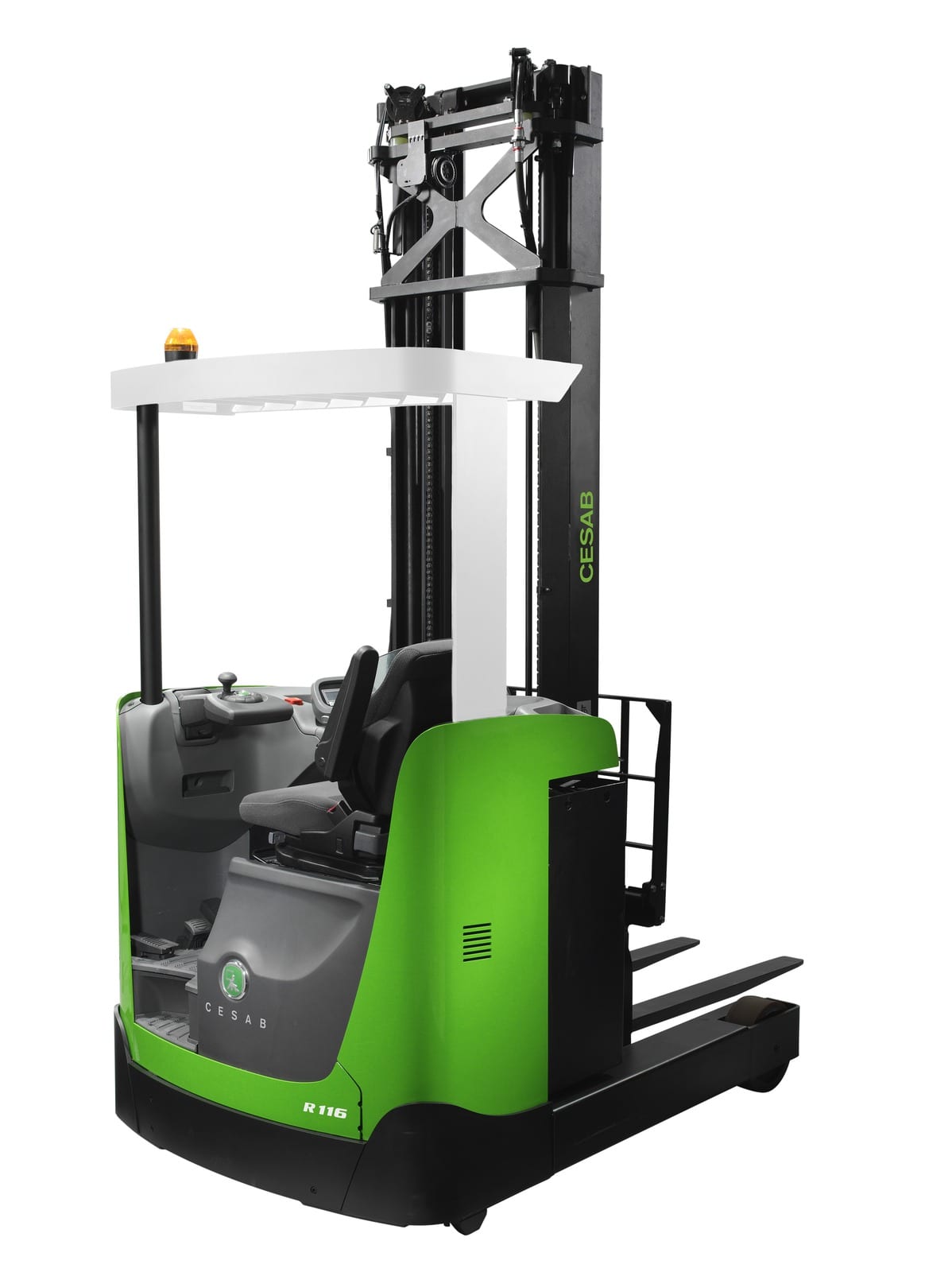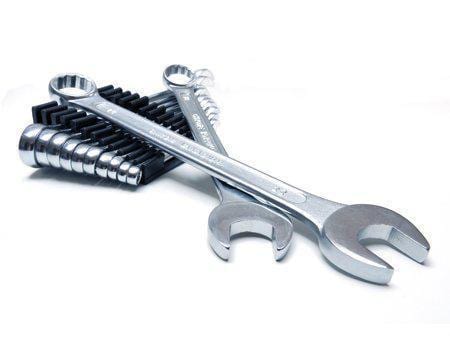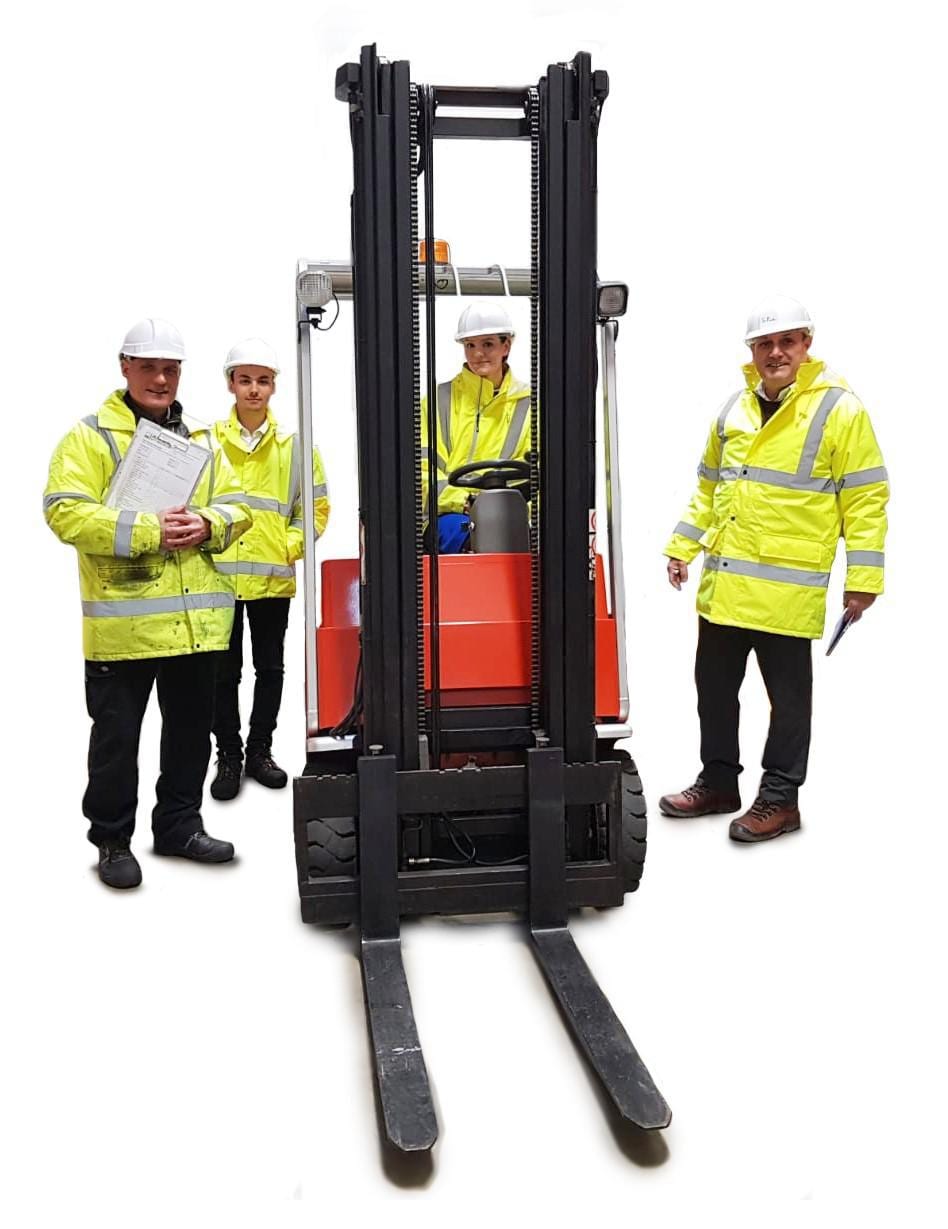Electric forklifts are a crucial part of modern warehouse operations. Electric forklift batteries are a quiet, sustainable, and cost-effective power source, making electric forklift trucks a more attractive option than propane-powered alternatives.
It’s essential to practice good fork truck battery maintenance if you want to keep getting value from your warehouse equipment. So, here’s a no-nonsense guide with everything you need to know about forklift batteries.
Start by listening to our podcast episode on the most important stuff you need to know on fork trucks, batteries, and their maintenance:
Forklift Battery Types
There are three main types of forklift batteries. They include:
- Lithium-ion
- absorbed glass mat (AGM)
- Lead-acid batteries.
They all power forklifts as they work and need to recharge routinely. Some types need periodic maintenance to keep them running their best.
We’re going to look at all three types in-depth so you have a complete guide to forklift batteries and maintenance.
Lithium-Ion Forklift Batteries
Lithium-ion batteries are more expensive than other types. But, they are increasingly popular in forklifts because they’re basically maintenance-free, don’t need watering, and are safer for workers to use. In addition, they can charge quickly, equating to better forklift productivity.
Lithium-ion batteries are also much lighter than other kinds of batteries, making them easier to handle. But, exposing them to high temperatures or storing them in a fully-charged state risks damage.
The big downside of lithium-ion batteries is that they can be very expensive.
Lithium-Ion Forklift Batteries Recharging
Lithium-ion batteries are increasingly common, and not just on forklifts. They’re considerably easier to recharge than lead-acid batteries, and they’re lighter than AGM batteries. But, they still carry risks of fire when mishandled or charged improperly.
Here are some specific forklift battery maintenance and recharging tips to keep in mind when recharging lithium-ion batteries.
- Always use the correct charger and only buy forklift batteries from a reputable source.
- Allow batteries to cool down after use and before attempting to recharge them.
- Batteries should always be charged on a hard, flat surface in a stable and well-ventilated area so that heat can dissipate as much as possible.
- Never use or recharge a battery that’s been damaged, and never expose one to high heat.
- Power down your charging equipment when it’s not in use.
- Never store lithium-ion batteries when they’re fully charged.
Lithium-Ion Forklift Batteries Maintenance
Lithium-ion batteries don’t require maintenance. There are no serviceable parts inside of them, so don’t try to tinker with one. If you think it needs replacement, contact a reputable vendor.
Looking to Buy or Hire
![Forklifts Hire & Rental prices in Leicester, Northampton, Derby, Warwick, East Midlands, West Midlands, Birmingham and Nottingham]()
a forklift?
With 35+ years of experience, we offer our most competitive rates, flexible finance, 4h service promise & more!
Looking to Buy or Hire

a forklift?
With 35+ years of experience, we offer our most competitive rates, flexible finance, 4h service promise & more!
Absorbed Glass Mat (AGM) Forklift Batteries
AGM batteries use a system of plates and a glass mat to pass electrons and store them in a dry state. These batteries don’t need watering and are nearly maintenance-free. That means they don’t bring a risk of spilt battery acid in the event a case cracks.
They also tend to be quite durable.
Absorbed Glass Mat (AGM) Forklift Batteries Recharging
Absorbed glass mat batteries generally have a high power output and a short recharging cycle. When charged with the appropriate equipment, an AGM battery might charge up to five times faster than a similarly-sized lead-acid battery.
They hold charge for quite a long time, so you don’t need to top them off if they’ve been sitting unused for a period. Unlike lead-acid batteries, AGM batteries don’t need a booster charge to prevent sulfation.
It’s a relatively simple procedure to connect the clamps from your leads to the positive and negative terminals and recharge an AGM battery.
However, these batteries mustn’t be overcharged. Doing so will significantly diminish their lifespan. For the best results, cycle these batteries by using them until they are about 50% depleted, and then charge them until they are full and no more.
AGM batteries will begin to lose their charging capacity in a few years, even with proper charging.
Absorbed Glass Mat (AGM) Forklift Batteries Maintenance
AGM batteries don’t require lots of upkeep, which helps minimize fork truck battery maintenance. The disadvantages of using AGM batteries are twofold. First, they have a high production cost. Secondly, they don’t have a very high specific energy, and that means that they can quietly deplete quickly when they run for a long time under a moderate to heavy load.
Specific energy is a term related to the overall energy stored in a battery. It’s not something you usually have to think about, but you should understand that in a very busy warehouse where the forklift is constantly under load and working, these batteries will be knackered before either a lead-acid or lithium-ion battery.
Lead-Acid Forklift Batteries
Lead-acid batteries are the oldest technology but still the most common forklift battery. Inside of their cases, these ‘wet-cell’ batteries contain a solution of sulfuric acid and water. That mixture stores the energy of the battery but poses a risk of damage if the case cracks and leaks. They also require regular watering to maintain their electrolyte levels.
Watering batteries require specialized equipment and skilled employees to use it. There is significant maintenance involved in lead-acid batteries. But, when maintained properly, they can last for years.
Lead-Acid Forklift Batteries Recharging
Lead-acid batteries are susceptible to problems if they are short-cycled or removed from chargers before they’ve fully charged. So, try to avoid cutting charging cycles short and recharge them to full capacity often.
If a lead-acid battery becomes discharged, charge it as soon as you can. Doing so can help you avoid sulfation, which reduces the life of the battery overall, and negatively affects its run time on each charge. It’s best to never to let a lead-acid battery discharge more than 80% of its energy before you recharge it.
For best results, plan for routine charging of your lead-acid batteries on a set schedule. Pretty much every day, the battery should be connected to a properly sized and manufacturer-approved charging device. Make sure to ventilate the battery by lifting the hood while charging it.
Always power the charger off before disconnecting the battery. Doing so can help prevent sparking and potential injury. Always control the temperature in the area of your shop where lead-acid batteries charge. Ideally, the battery should stay close to 25 degrees Celsius.
Since it usually takes about ten hours to recharge a lead-acid battery fully, you may find it works well to recharge your batteries overnight. However, if your warehouse runs multiple shifts, that may not be practical.
You have to find a way to manage a charging schedule that cycles your batteries well. That means depleting them until they only have 20-30% of charge remaining and then recharging them 100% without interruption.
Lead-Acid Forklift Batteries Maintenance
Lead-acid batteries are maintenance intensive. Their performance can be affected by temperature changes and poor charging practices. Always follow the battery manufacturer’s guidance for the proper charging equipment, handling practices, and charging cycles for optimal forklift battery maintenance.
It’s considered best practice to maintain a thorough log of all battery maintenance. Doing so may come in handy if you have to make a warranty claim.
Lead-Acid Forklift Batteries Watering
Having the proper amount of water in your battery is essential for it to function at its best and provide you with the run time you need for your forklift. Ideally, you should maintain a schedule to check the fluid level of all your lead-acid batteries.
Every week, or after about five full charging cycles, a trained technician needs to water the batteries. Watering is a process where someone checks the water levels in each cell of the lead-acid batteries. It’s essential to wear proper PPE while watering lead-acid batteries.
Ideally, the water levels are checked when the battery is at the end of a charging cycle. Make sure to fill each cell until the level is approximately six or seven millimeters below the vent hole. This space allows for a bit of extra margin in case of tipping and helps minimize spilling. Then, properly mix the electrolyte and water by providing an equalization charge.
The water you use for watering batteries should have a pH between 5 and 7, making it slightly acidic. Check the information that came with your battery at the time you purchased it for all the details you need to water it.
Each month, a technician should use a hydrometer to test each lead-acid battery’s specific gravity, cell by cell. This gravity reading should be performed when the battery has completed its charging cycle.
When fully charged, common forklift batteries often indicate an ideal specific gravity of 1.285. But that may vary by type and manufacturer, so always check the documentation for your particular battery.
This monthly hydrometer test is also a good time for an inspection of the cables and connectors. Any indications of burning, pitting, or corrosion should be addressed. It’s a good idea to use a battery-neutralizing cleaner to wipe down the case of the battery.
Forklift Battery Safety Tips
Forklift batteries can be hazardous, yet forklifts are used by a wide range of industries, from locksmiths (yes, you heard that right), to auction houses. Technicians need to be cautious when moving, lifting, charging, cleaning, or otherwise servicing them. In addition to any site-specific safety measures, you should also:
- Wear appropriate Personal Protective Equipment (PPE) like gloves, eye protection, and steel-toed boots.
- Always have safety equipment on hand, like a first aid kit, sink, and eyewash station.
- Lift batteries safely with the proper equipment, and never try to lift one by hand.
- Never reinstall a battery with a frayed cable, cracked case, or pronounced corrosion.
- Never store batteries in an area that may see excessive heat or cold.
Looking to Buy or Hire

a forklift?
With 35+ years of experience, we offer our most competitive rates, flexible finance, 4h service promise & more!
Forklift Truck Battery Maintenance Checklist
Fork battery maintenance extends the life of your batteries and protects your investment. Let’s get down to business with a straightforward and easy-to-follow checklist for better maintenance.
#1. Charge the battery correctly
Extending the lifecycle of your battery requires disciplined and scheduled charging. Wait until they drain to 10% or 20%, and then let them charge fully. Always use the right current voltage and output.
#2. Check fluid after every two to three charges
Forklift battery maintenance best practices involve scheduling batter fluid checks every two to three charges.
#3. Equalization gets rid of sulfate crystal build-up
Schedule equalization to remove sulfate crystal build-up. Once a week is a good cadence for batteries used multiple times a day; a month works for lightly used machines.
#4. Keep an eye on temperatures
Ensure you know the recommended temperature limits of your batteries and ensure they stay within those ranges. Check temperatures after charging and during use.
#5. Clean your battery monthly
Regular use can cause particles or electrolytes to build up in your unit. Clean your unit down with warm water and a battery cleaner. Once per month will do the trick.
Follow these five simple steps for flawless fork truck battery maintenance.
Forklift Battery FAQ
Some questions about forklift batteries come up all the time.
How long do forklift batteries last?
A well-maintained forklift battery can last for years. If you don’t cycle a lead-acid battery properly, it will wear out faster.
How many volts is a forklift battery?
Forklift batteries are usually either six or 12 volts.
Why do forklift batteries explode?
Forklift batteries rarely explode when maintained and used properly. When charred or serviced in a dangerous fashion or by some chinless wonder, that’s when things go wrong and the battery may explode.
How to test forklift batteries?
You test batteries differently depending on their type. Lead-acid batteries need hydrometer testing to check their water levels.
How to recondition forklift batteries?
You can recondition a forklift battery by having it professionally inspected for corrosion, and you can also replace parts and repaint them to restore their appearance and function.
How long do electric forklift batteries last?
A forklift battery can easily last for three years or more. A well-maintained battery may last longer than five years.
Where to buy forklift batteries?
You can easily buy whatever forklift battery you might need at Angus Lift Trucks.
How much do forklift batteries weigh?
A forklift battery can be quite heavy. Lithium-ion batteries may weigh 12 to 15 kilos or more. Lead-acid batteries might weigh 30 kilos or more.
How much do forklift batteries cost?
The price of a forklift battery can be as little as 150 pounds or as much as 400 pounds. It all depends on the specific battery. In general, lead-acid batteries are the least expensive option. For best pricing, contact Angus Lift Trucks.
How to charge forklift batteries?
Charging a forklift battery isn’t always simple. So follow our detailed guide for the best results.
Can you overcharge a forklift battery?
Yes, it’s easy to overcharge a lead-acid forklift battery.
How often should forklift batteries be watered?
You should water a lead-acid battery approximately every five charging cycles.
When do forklift batteries fail?
Forklift batteries fail when they can no longer hold a charge. A well-maintained lead-acid battery may perform well for up to 1,600 charging cycles. Assuming a rate of one charge per day, that’s more than four years of life.
You may also like
Forklift Battery Bottom Line
If you follow this guide, you’ll be able to stay on top of your fork truck battery maintenance. That means they’ll keep running well and producing value for your business.
. Doing so will keep them running well longer than if you neglect proper charging and maintenance practices.
The workload, charging cycle, and price of a forklift battery vary by type, so choose one that works for your warehouse and its particular rhythm.
If you have questions or need advice, contact Angus Lift Trucks for all your forklift battery, service, parts, hire, training, and sales needs.
This post is also available in:
Français
Deutsch
Italiano
Português
Español
Български
Hrvatski
Eesti
Latviešu
Lietuvių
Polski
Português
Русский
Slovenčina
Slovenščina
Türkçe
Українська
Albanian
Čeština
Dansk
Nederlands
Ελληνικά
Magyar
Română
